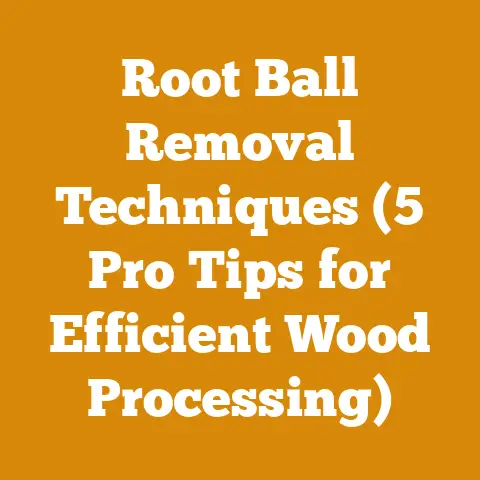Damaged Bark on Young Tree: Repair Tips for Apple Growers (Expert Insights)
Understanding Bark Damage on Young Apple Trees
Bark damage on young apple trees can be a serious issue, potentially stunting growth, reducing fruit production, and even leading to the tree’s demise. The bark is the tree’s protective layer, shielding it from pests, diseases, and environmental stressors. When this barrier is compromised, the tree becomes vulnerable.
Common Causes of Bark Damage
Several factors can cause bark damage on young apple trees, and understanding these is the first step in prevention and treatment:
- Animal Damage: Rodents like mice and voles, as well as larger animals like deer and rabbits, often gnaw on the bark, especially during winter when other food sources are scarce.
- Environmental Factors: Sunscald, caused by rapid temperature fluctuations, can lead to bark splitting. Frost cracks, resulting from freezing and thawing cycles, are also common.
- Mechanical Injuries: These can occur from lawnmowers, weed whackers, or even accidental bumps during orchard maintenance.
- Pests and Diseases: Certain insects, such as borers, can tunnel under the bark, causing significant damage. Fungal diseases can also lead to bark lesions and decay.
Identifying the Type of Damage
Accurately identifying the type of damage is crucial for effective treatment. Here’s a breakdown:
- Girdling: This occurs when the bark is completely removed around the circumference of the tree, cutting off the flow of nutrients and water.
- Partial Bark Removal: This involves damage to a portion of the bark, leaving the underlying wood exposed.
- Sunscald: This appears as elongated, sunken areas on the south or southwest side of the tree.
- Frost Cracks: These are vertical cracks that often occur on the trunk.
- Borer Damage: Look for small holes in the bark, often accompanied by sawdust-like frass.
Assessing the Severity of the Damage
Before taking action, it’s essential to assess the severity of the damage. Minor scratches and superficial wounds may heal on their own, while more extensive damage requires immediate intervention.
Factors to Consider
- Size of the Wound: Larger wounds are more likely to lead to infection and decay.
- Depth of the Damage: If the damage extends to the cambium layer (the layer just beneath the bark responsible for growth), the tree’s health is at greater risk.
- Location of the Damage: Girdling is the most severe type of damage, as it can kill the tree if not addressed promptly.
- Overall Tree Health: A healthy, vigorous tree is more likely to recover from bark damage than a stressed or weakened one.
Repairing Damaged Bark: Step-by-Step Guide
Once you’ve assessed the damage, it’s time to take action. Here’s a step-by-step guide to repairing damaged bark on young apple trees:
Step 1: Gather Your Supplies
Before you begin, gather the necessary tools and materials:
- Sharp Pruning Knife or Grafting Knife: Essential for cleaning up the wound.
- Clean Cloth: For wiping away debris.
- Water: For rinsing the wound.
- Tree Wound Sealant: Choose an eco-friendly, non-toxic sealant.
- Grafting Tape or Tree Wrap: For protecting the repaired area.
- Protective Gear: Gloves and eye protection are recommended.
Step 2: Clean the Wound
Using a sharp pruning knife or grafting knife, carefully remove any loose or ragged bark around the damaged area. Be sure to cut back to healthy, living tissue. This step is crucial for preventing infection and promoting healing.
- Technique: Hold the knife at a slight angle and make smooth, clean cuts. Avoid tearing the bark.
- Caution: Be careful not to damage the cambium layer. This thin layer of cells is responsible for the tree’s growth.
Step 3: Disinfect the Wound
After cleaning the wound, disinfect it with a mild solution of water and bleach (1 part bleach to 10 parts water). This will help kill any bacteria or fungi that may be present.
- Application: Use a clean cloth to apply the solution to the wound.
- Drying Time: Allow the wound to dry completely before proceeding to the next step.
Step 4: Apply Tree Wound Sealant
Apply a thin, even layer of tree wound sealant to the cleaned and disinfected area. This will protect the wound from pests, diseases, and environmental stressors.
- Sealant Choice: Choose an eco-friendly, non-toxic sealant that is specifically designed for tree wounds. Avoid using petroleum-based products, as these can be harmful to the tree.
- Application Technique: Use a brush or spatula to apply the sealant. Be sure to cover the entire wound, including the edges.
Step 5: Wrap the Repaired Area
Wrap the repaired area with grafting tape or tree wrap to provide additional protection and support. This will help hold the bark in place and prevent the sealant from drying out too quickly.
- Wrapping Technique: Start at the bottom of the wound and work your way up, overlapping each layer of tape or wrap.
- Tightness: Wrap the area snugly, but not too tightly, as this can restrict the flow of nutrients and water.
Step 6: Monitor the Healing Process
Regularly monitor the repaired area for signs of healing. Look for new bark growth and the formation of callus tissue (a protective layer that forms over the wound).
- Frequency: Check the wound every few weeks, especially during the growing season.
- Signs of Infection: If you notice any signs of infection, such as oozing sap or discoloration, re-clean the wound and reapply the sealant.
Specific Repair Techniques for Different Types of Damage
The repair techniques may vary depending on the type of damage. Here are some specific approaches for common issues:
Girdling
Girdling is a severe form of bark damage that requires immediate attention. Here are two repair options:
- Bridge Grafting: This involves connecting the bark above and below the girdled area with small pieces of branchwood.
- Procedure:
- Cut small pieces of branchwood (scions) from a healthy part of the tree.
- Make incisions above and below the girdled area.
- Insert the scions into the incisions, ensuring that the cambium layers are aligned.
- Wrap the grafted areas with grafting tape.
- Success Rate: Bridge grafting can be successful if done properly, but it requires skill and patience.
- Procedure:
- Inarching: This involves planting young trees (rootstocks) around the base of the girdled tree and grafting them to the trunk above the damaged area.
- Procedure:
- Plant several young trees around the base of the girdled tree.
- Graft the tops of the young trees to the trunk above the girdled area.
- Wrap the grafted areas with grafting tape.
- Advantages: Inarching provides a more robust and reliable connection than bridge grafting.
- Procedure:
Partial Bark Removal
For partial bark removal, the goal is to protect the exposed wood and promote healing.
- Cleaning and Sealing: Follow the steps outlined above for cleaning the wound, disinfecting it, and applying tree wound sealant.
- Bark Flap Reattachment: If the bark flap is still attached, carefully reattach it to the tree using grafting tape or small nails.
- Wound Dressing: Consider using a wound dressing to provide additional protection and moisture retention.
Sunscald and Frost Cracks
Sunscald and frost cracks are caused by environmental factors, so prevention is key. However, if damage does occur, here’s how to address it:
- Cleaning and Sealing: Clean the damaged area and apply tree wound sealant.
- Tree Wrap: Wrap the trunk with tree wrap to protect it from further temperature fluctuations.
- Whitewashing: Apply a whitewash solution to the trunk to reflect sunlight and reduce the risk of sunscald.
Borer Damage
Borer damage can be difficult to treat, as the insects tunnel under the bark. Here’s how to address it:
- Removal: Use a wire or small knife to remove the borers from the tunnels.
- Insecticide Application: Apply an insecticide specifically designed for borers to the affected area.
- Preventative Measures: Take preventative measures to deter borers, such as keeping the tree healthy and vigorous.
Preventing Bark Damage: Proactive Strategies
Prevention is always better than cure. Here are some proactive strategies to prevent bark damage on young apple trees:
Animal Protection
- Tree Guards: Install tree guards around the base of the trees to protect them from rodents and other animals.
- Fencing: Erect a fence around the orchard to keep out deer and rabbits.
- Repellents: Apply animal repellents to the bark to deter animals from gnawing on it.
Environmental Protection
- Tree Wrap: Wrap the trunks of young trees with tree wrap to protect them from sunscald and frost cracks.
- Whitewashing: Apply a whitewash solution to the trunks to reflect sunlight.
- Proper Irrigation: Ensure that the trees receive adequate water to prevent stress and cracking.
Mechanical Injury Prevention
- Careful Mowing: Use caution when mowing or weed-whacking around the trees to avoid hitting the bark.
- Protective Barriers: Install protective barriers around the base of the trees to prevent accidental damage.
- Proper Training: Train orchard workers on proper tree care techniques to minimize the risk of injury.
Pest and Disease Management
- Regular Monitoring: Regularly monitor the trees for signs of pests and diseases.
- Integrated Pest Management (IPM): Implement an IPM program to control pests and diseases in an environmentally friendly way.
- Proper Pruning: Prune the trees properly to promote air circulation and reduce the risk of fungal diseases.
The Science Behind Bark Healing
Understanding the science behind bark healing can help you make informed decisions about repair techniques.
Wood Anatomy and Properties
The bark is composed of several layers, each with its own function:
- Outer Bark (Rhytidome): This is the outermost layer, which provides protection from the environment.
- Inner Bark (Phloem): This layer transports sugars from the leaves to the rest of the tree.
- Cambium: This is a thin layer of cells that is responsible for growth. It produces new phloem cells on the inside and new xylem cells (wood) on the outside.
- Xylem (Wood): This layer transports water and nutrients from the roots to the leaves.
The Healing Process
When the bark is damaged, the tree initiates a complex healing process:
- Callus Formation: The cambium cells around the wound begin to divide rapidly, forming a protective layer of callus tissue.
- Wound Closure: The callus tissue gradually grows over the wound, eventually closing it completely.
- Bark Regeneration: New bark cells are produced to replace the damaged tissue.
Factors Affecting Healing
Several factors can affect the healing process:
- Tree Health: A healthy, vigorous tree is more likely to heal quickly and effectively.
- Wound Size: Smaller wounds heal more quickly than larger wounds.
- Environmental Conditions: Warm, moist conditions promote healing, while cold, dry conditions can slow it down.
- Proper Care: Proper cleaning, sealing, and wrapping of the wound can significantly improve the healing process.
Case Studies: Successful Bark Repair
To illustrate the effectiveness of these techniques, here are a few case studies:
Case Study 1: Girdling Repair with Bridge Grafting
- Problem: A young apple tree was girdled by rabbits during the winter.
- Solution: The grower performed bridge grafting, connecting the bark above and below the girdled area with small pieces of branchwood.
- Result: The grafts took successfully, and the tree recovered fully.
Case Study 2: Partial Bark Removal Repair
- Problem: A lawnmower accidentally damaged the bark on a young apple tree.
- Solution: The grower cleaned the wound, applied tree wound sealant, and wrapped the area with grafting tape.
- Result: The wound healed completely, and the tree continued to grow vigorously.
Case Study 3: Sunscald Prevention
- Problem: Young apple trees were suffering from sunscald on the south side of the trunks.
- Solution: The grower wrapped the trunks with tree wrap and applied a whitewash solution.
- Result: The trees were protected from further sunscald damage, and their health improved significantly.
Expert Insights and Tips
Here are some additional expert insights and tips to help you successfully repair damaged bark on young apple trees:
- Timing: The best time to repair bark damage is during the growing season, when the tree is actively growing and healing.
- Sharp Tools: Always use sharp pruning knives or grafting knives to make clean cuts.
- Cleanliness: Keep your tools clean and disinfected to prevent the spread of disease.
- Patience: Healing can take time, so be patient and monitor the repaired area regularly.
- Consult an Expert: If you’re unsure about how to repair bark damage, consult with a certified arborist or horticulturalist.
Eco-Friendly Options for Bark Repair
As apple growers, we have a responsibility to use eco-friendly practices whenever possible. Here are some eco-friendly options for bark repair:
- Organic Tree Wound Sealants: Choose tree wound sealants that are made from natural ingredients and are free from harmful chemicals.
- Beneficial Insects: Encourage beneficial insects, such as ladybugs and lacewings, to help control pests that can damage bark.
- Compost Tea: Apply compost tea to the soil around the trees to improve their health and vigor.
- Natural Repellents: Use natural animal repellents, such as garlic spray or hot pepper spray, to deter animals from gnawing on the bark.
Integrating Bark Repair into Orchard Management
Bark repair should be an integral part of your overall orchard management plan. Here are some tips for integrating bark repair into your routine:
- Regular Inspections: Regularly inspect your trees for signs of bark damage.
- Preventative Maintenance: Take preventative measures to protect your trees from animal damage, environmental factors, and mechanical injuries.
- Record Keeping: Keep detailed records of bark damage and repair efforts.
- Training: Train your orchard workers on proper bark repair techniques.
The Future of Bark Repair
As technology advances, new and innovative bark repair techniques are emerging. Here are some trends to watch:
- Bioprinting: Researchers are exploring the possibility of using bioprinting to create artificial bark that can be grafted onto damaged trees.
- Nanotechnology: Nanoparticles are being developed to deliver nutrients and protectants directly to the wound site.
- Genetic Engineering: Scientists are working to develop apple tree varieties that are more resistant to bark damage.
Conclusion: Nurturing the Future of Your Orchard
Repairing damaged bark on young apple trees is a vital aspect of orchard management. By understanding the causes of bark damage, assessing its severity, and implementing effective repair techniques, you can ensure the long-term health and productivity of your trees. Remember to prioritize eco-friendly options and integrate bark repair into your overall orchard management plan. With patience, diligence, and a commitment to sustainable practices, you can nurture the future of your orchard and enjoy a bountiful harvest for years to come.
As I reflect on years spent tending to my own small apple orchard, I recall a particularly harsh winter where the rabbit population exploded. Despite my best efforts with fencing, several young trees suffered significant girdling. It was a disheartening sight, but it spurred me to learn everything I could about bridge grafting. The process was meticulous, requiring steady hands and a keen eye for detail. But seeing those grafts take, watching the sap flow resume, and witnessing the trees regain their vigor was immensely rewarding. It reinforced the idea that even in the face of adversity, with the right knowledge and a little bit of care, we can help our trees overcome challenges and thrive.






